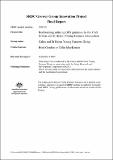| Abstract | This project aimed to enhance controlled traffic farming with GPS guidance in undulating conditions in the Calen and St Helen district of Mackay. The project focused on the use of preformed beds, as well as investigating different planting techniques (eg dual row and wide shute on preformed beds). The group also wanted to investigate the potential for a contracting facility to bed form under guidance. Key results from the project include: - Controlled traffic systems were enhanced through the use of GPS. Without GPS we had issues with maintaining even row spacings along the contours and side slopes, and holding a billet planter in position on slopes. Through the use of GPS, and the Alexander (flat top) bed former, we were able to overcome these issues. - We found that the flat top bed shape formed with the Alexander bed former was the most suitable for our region. While the trial results indicated there was no yield, NIR or financial difference between the flat top, round top bed and conventional planting, we found the flat top beds were much easier to manage in our undulating farming conditions as the tractor/planter can more easily stay on the wheel ruts and not stray from the desired position. With the flat top bed former we found we could mark out with a GPS tractor and then conduct other paddock operations without the GPS because the bed shapes kept the tractor and implement in the GPS wheel tracks. o The flat top beds provided the best wheel track for our planting equipment, as this profile seemed to form a “railway like track centre”, making it very easy to keep the planter in the correct position without the need for GPS guidance. The round beds seem to have a wider wheel space and we experienced some movement and uneven row spacing, however this could be eliminated with the use of guidance equipment on the planting gear (which we don’t have). -Different planting techniques on preformed beds had very similar yields. The dual rows on preformed beds performed the worst with a yield of 103.7 t/ha, compared to singles on beds and conventional planting with 108.63 and 107.81 t/ha respectively. o Based on the gross return per hectare, the single wide shute treatments planted on preformed beds performed the best with a return of $2,582.78 per hectare. However the conventional treatment was very close with a return of $2,539.34 per hectare. The dual rows had a return of $2,464.90 per hectare. Across the treatments there was only a difference of $117.88/ha. - A FEAT analysis conducted by a DPI economist showed that the group’s cur rent farming system (controlled traffic and tilled system) resulted in a Farm Operating Return of $20, 070 and a Return on Investment of 1.44%. While the improved farming system which involves controlled traffic, preformed beds, soybean fallow and reduced tillage resulted in a Farm Operating Return of $54, 947 and a Return on Investment of 3.94%. - There was very little difference in yield and NIR data between the conventional planting method, and the two different bed shapes. The CASH preformed beds, which have a flat shape, had the highest yield with 98.97 t/ha, however it also had the lowest PRS. Tonnes of sugar per hectare across the treatments were almost identical and as a result the Gross Return per hectare only had a difference of $29 between the treatments. o While there was no major difference in gross return between the treatments, we noticed that the flat bed shape was much easier to form, plant and harvest, compared to the round shape. F:\New folder\SRDC\SRDC USB\MRD\Projects - GGIP\Archive\GGP021\Final Report\100426 GGP021_final_report - final.doc - Preliminary results indicate that the flat top bed system has much greater water infiltration and plant extraction than the other systems. However more detailed, long term work needs to be conducted before final conclusions can be drawn. -In 2007 approximately 160 acres outside of the group members farms was contract bed formed, and an additional 100 acres was contract bed formed in 2008. The equipment will continue to be available for hire into the future. - The group members have determined that in this area, preformed beds are essential for a successful legume fallow. All group members will use the bed former prior to planting soybean. |

